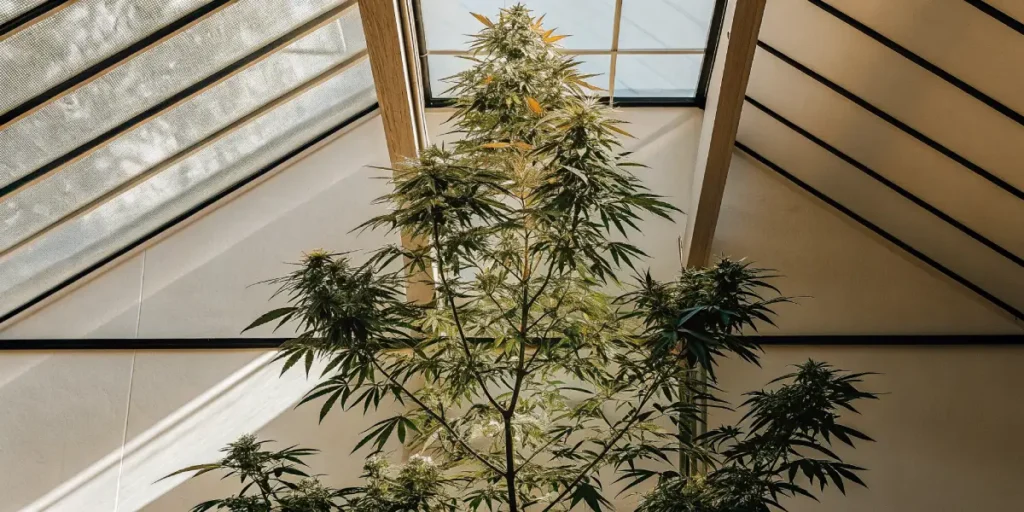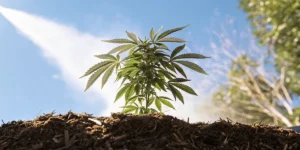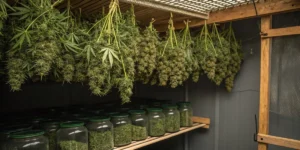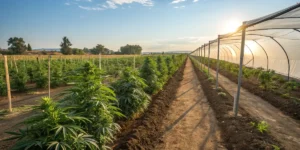Low stress training (LST) is a popular method among cannabis growers that involves gently bending and tying down plant branches. This technique helps maximize light exposure and promote more even growth. When comparing plants before and after low stress training, you can see significant improvements in structure and yield. The process might seem daunting at first, but with practice, it becomes an invaluable tool in your gardening toolkit.
Imagine growing a cannabis plant that is bushy, with colas evenly distributed, rather than one tall stem. This is what low stress training can achieve. By carefully manipulating the plant, you can increase light penetration to lower branches and enhance overall growth. The results are often visible in just a few weeks, showcasing the effectiveness of low stress training techniques.
For instance, when applying LST to strains like “Blue Dream,” “White Widow,” or “Northern Lights” from Global Green Genetics, you can enhance their natural characteristics by promoting lateral growth. These strains respond well to training, producing impressive before and after LST plant growth that can boost your confidence as a grower.
Techniques for Low Stress Training
Low stress training techniques are simple yet effective. Start by identifying the branches that need to be adjusted. Gently bend them to a horizontal position and secure them with soft ties. This process encourages the plant to focus its energy on developing more colas instead of growing tall and lanky.
When applied correctly, these techniques result in a plant that utilizes light more efficiently. The impact of low stress training on yield is often noticeable, with buds developing more uniformly. By spreading out the plant’s canopy, you ensure that all parts receive adequate light, leading to healthier and more robust growth.
Another critical aspect of LST is the timing. Applying the technique at the right stage of growth, usually during the vegetative stage, ensures the plant is flexible enough to adapt to the new structure. This adaptability is crucial for maximizing the effectiveness of low stress training techniques and achieving optimal results.
Furthermore, the low stress training results comparison between trained and untrained plants can be substantial. Trained plants often exhibit more vigorous growth patterns and an increased number of bud sites, offering a clear advantage in the cultivation process. The difference in before and after low stress training is evident, reinforcing the technique’s value.
Step-by-Step Low Stress Training
Begin by choosing a young plant, ideally in the vegetative stage. This is the best time for training as the plant is still flexible and can easily adapt to new shapes. Handle the plant with care to avoid breaking any branches.
Use garden ties or soft string to gently pull the branches down and secure them to the rim of the pot. Ensure the ties are not too tight to allow for growth and prevent damage. Adjust the ties as the plant grows to maintain its shape.
As you implement these steps, it’s essential to observe the plant’s response. The plant’s adaptation to its new shape is a testament to the effectiveness of low stress training techniques. Regular monitoring and adjusting of ties ensure that the plant remains healthy and continues to thrive.
Moreover, taking low stress training before after photos can be an excellent way to document the changes and improvements. These images can provide a visual representation of your progress and serve as a guide for future grows, allowing you to refine your techniques and maximize your yield.
Analyzing Results of Low Stress Training
After applying LST, it’s crucial to monitor the plant’s progress. Regularly check the ties and adjust them as necessary to accommodate growth. This ongoing care ensures optimal results and prevents any potential harm to the plant.
The effectiveness of low stress training techniques is often visible within weeks. You may even want to document the changes with low stress training before after photos. These images can serve as a useful reference for future grows and help you refine your technique.
In addition to visual assessment, growers can use low stress training results comparison to evaluate the impact of the technique on different strains. By comparing yields, bud formation, and overall plant health, you can better understand how LST affects various plant types and optimize your approach accordingly.
The before and after LST plant growth is not just about aesthetics; it’s about the health and productivity of the plant. By analyzing the results, you can make informed decisions about future training sessions and continually improve your cultivation practices.

Real-Life Examples of LST Success
One grower applied LST to their “White Widow” plants from Global Green Genetics and reported a significant increase in yield. The plant’s structure became more manageable, and the light penetration improved drastically. The before and after LST plant growth was remarkable, with fuller, healthier buds.
Another grower experimented with “Northern Lights” and saw similar results. The plant developed multiple main colas, significantly boosting the harvest. Such examples highlight the positive impact of low stress training on yield, making it a favored method among both novice and experienced growers.
These success stories are backed by consistent observations of the plants’ reactions to LST. The growers noted that the low stress training results comparison with their previous untrained efforts was particularly striking, with trained plants showing superior yield and health.
By sharing these experiences, growers can encourage others to adopt LST and refine their techniques. The before and after low stress training transformations serve as powerful motivation for those looking to enhance their growing operations and achieve similar success.
FAQs
What is low stress training?
Low stress training, or LST, is a cultivation technique used to manipulate the shape of a cannabis plant. By gently bending and tying down branches, growers can encourage the plant to grow in a more horizontal manner. This increases light exposure to all parts of the plant, promoting even growth and potentially higher yields.
LST is particularly useful for indoor growers with limited space. It allows for better use of available light and can prevent the plant from becoming too tall. The technique is easy to learn and, with practice, can greatly enhance the effectiveness of your grow operation.
Understanding the before and after low stress training process is crucial for growers aiming to maximize their plants’ potential. The transformation is not only about the plant’s appearance but also about its overall health and productivity. This makes LST a valuable technique for growers at any level.
Additionally, the low stress training results comparison between different strains provides insights into how various plants respond to this method. This knowledge can guide growers in selecting the best strains for their specific growing conditions and goals.
How does low stress training impact yield?
Low stress training can have a positive impact on yield by increasing the number of main colas on a plant. By spreading out the plant’s canopy, LST ensures that all bud sites receive adequate light. This can lead to more uniform bud development and, ultimately, a larger harvest.
Growers often report noticeable improvements in yield after implementing LST. The technique is effective across various strains, including those available at Global Green Genetics, such as “Blue Dream” and “Northern Lights.” The results speak for themselves, with many growers showcasing impressive low stress training before after photos.
The impact of low stress training on yield is not just theoretical; it’s supported by countless grower testimonials and documented results. By increasing light penetration and improving airflow, LST creates an environment where plants can thrive, leading to healthier and more productive yields.
Moreover, the before and after LST plant growth provides a clear demonstration of how this technique can transform a plant’s potential. By encouraging lateral growth and optimizing canopy exposure, growers can achieve yields that exceed their expectations, further validating the effectiveness of low stress training techniques.
How long does it take to see results from LST?
Results from low stress training can vary depending on the strain and growing conditions. However, many growers begin to see changes within a few weeks. The plant’s structure becomes more open, allowing for better light penetration and airflow. This often leads to healthier growth and more bud sites.
Patience is key when it comes to LST. Regularly monitor the plant and adjust ties as needed to accommodate growth. Over time, the benefits of low stress training become evident, making it a worthwhile investment for any grower.
For those documenting their progress, low stress training before after photos serve as an excellent tool for tracking growth and development. These images not only highlight the physical changes but also help growers refine their techniques for future grows.
The low stress training results comparison can also provide valuable insights into the timing and effectiveness of the technique. By analyzing when changes occur and how they manifest, growers can better understand the nuances of LST and apply this knowledge to improve their cultivation practices.
Can I use LST on all cannabis strains?
While most cannabis strains can benefit from low stress training, some respond better than others. Indica-dominant strains, which naturally have a bushier growth pattern, tend to be more receptive to LST. However, with careful handling, sativa strains can also be trained successfully.
It’s important to research the specific strain you’re growing to understand its characteristics. Strains from Global Green Genetics, like “White Widow” and “Northern Lights,” are known for their adaptability to LST, making them excellent choices for growers looking to maximize their yields.
The adaptability of different strains to LST can significantly influence the before and after LST plant growth. Understanding these differences allows growers to tailor their approach and achieve the best possible outcomes for each specific strain.
Furthermore, the impact of low stress training on yield can vary between strains, making it essential for growers to experiment and document their results. By doing so, they can develop a more nuanced understanding of how each strain responds to LST and optimize their growing strategies accordingly.
What are common mistakes to avoid with LST?
One common mistake is applying too much pressure when bending branches, which can lead to breakage. Always handle the plant gently and use soft ties to secure branches. It’s also important to regularly check the ties to ensure they aren’t too tight and adjust them as the plant grows.
Another mistake is neglecting to monitor the plant’s progress. LST requires ongoing attention to ensure the plant continues to grow as desired. Keep an eye on the plant’s structure and make necessary adjustments to optimize light exposure and airflow. With care and patience, low stress training can yield impressive results.
Additionally, failing to document the before and after low stress training process can result in missed opportunities for learning and improvement. Using low stress training before after photos can help growers track their progress and identify areas for refinement.
Finally, not conducting a low stress training results comparison with previous grows can prevent growers from fully appreciating the technique’s impact. By comparing yields and plant health before and after LST, growers can gain valuable insights into the effectiveness of their methods and make informed decisions for future growing cycles.





